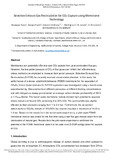JavaScript is disabled for your browser. Some features of this site may not work without it.
| dc.contributor.author | Russo, Giuseppe | |
| dc.contributor.author | Prpich, George | |
| dc.contributor.author | Anthony, Edward J. | |
| dc.contributor.author | Montagnaro, Fabio | |
| dc.contributor.author | Jurado Pontes, Nelia | |
| dc.contributor.author | Di Lorenzo, Giuseppina | |
| dc.contributor.author | Darabkhani, Hamidreza Gohari | |
| dc.date.accessioned | 2017-11-14T09:33:07Z | |
| dc.date.available | 2017-11-14T09:33:07Z | |
| dc.date.issued | 2017-11-10 | |
| dc.identifier.citation | Russo G, Prpich G, Anthony EJ, (2017) Selective-exhaust gas recirculation for CO2 capture using membrane technology, Journal of Membrane Science, Volume 549, March 2018, pp. 649-659 | en_UK |
| dc.identifier.issn | 0376-7388 | |
| dc.identifier.uri | https://doi.org/10.1016/j.memsci.2017.10.052 | |
| dc.identifier.uri | http://dspace.lib.cranfield.ac.uk/handle/1826/12716 | |
| dc.description.abstract | Membranes can potentially offer low-cost CO2 capture from post-combustion flue gas. However, the low partial pressure of CO2 in flue gases can inhibit their effectiveness unless methods are employed to increase their partial pressure. Selective-Exhaust Gas Recirculation (S-EGR) has recently received considerable attention. In this study, the performance of a dense polydimethylsiloxane (PDMS) membrane for the separation of CO2/N2 binary model mixtures for S-EGR application was investigated using a bench-scale experimental rig. Measurements at different pressures, at different feeding concentrations and with nitrogen as sweep gas revealed an average carbon dioxide permeability of 2943 ± 4.1%RSD Barrer. The bench-scale membrane module showed high potential to separate binary mixtures of N2 and CO2 containing 5–20% CO2. The permeability was slightly affected by feed pressures ranging from 1 to 2.4 bar. Furthermore, the separation selectivity for a CO2/N2 mixture of 10%/90% (by volume) reached a maximum of 10.55 at 1.8 bar. Based on the results from the bench-scale experiments, a pilot-scale PDMS membrane module was tested for the first time using a real flue gas mixture taken from the combustion of natural gas. Results from the pilot-scale experiments confirmed the potential of the PDMS membrane system to be used in an S-EGR configuration for capture of CO2. | en_UK |
| dc.language.iso | en | en_UK |
| dc.publisher | Elsevier | en_UK |
| dc.rights | Attribution-NonCommercial-NoDerivatives 4.0 International | |
| dc.rights.uri | http://creativecommons.org/licenses/by-nc-nd/4.0/ | |
| dc.title | Selective-exhaust gas recirculation for CO2 capture using membrane technology | en_UK |
| dc.type | Article | en_UK |
Files in this item
This item appears in the following Collection(s)
-
Staff publications (SWEE) [2825]

